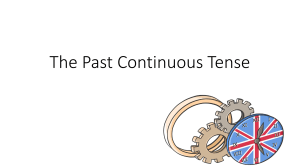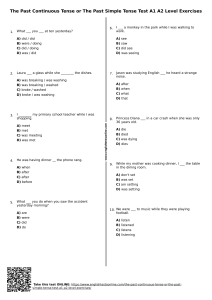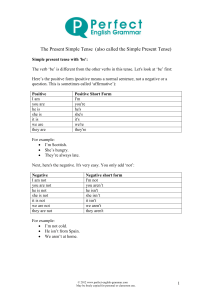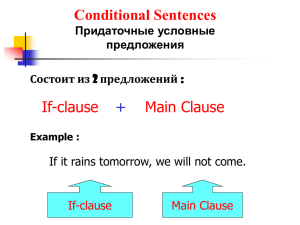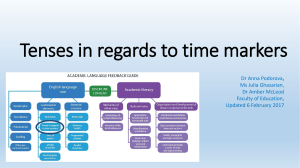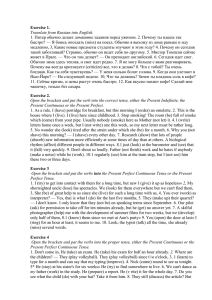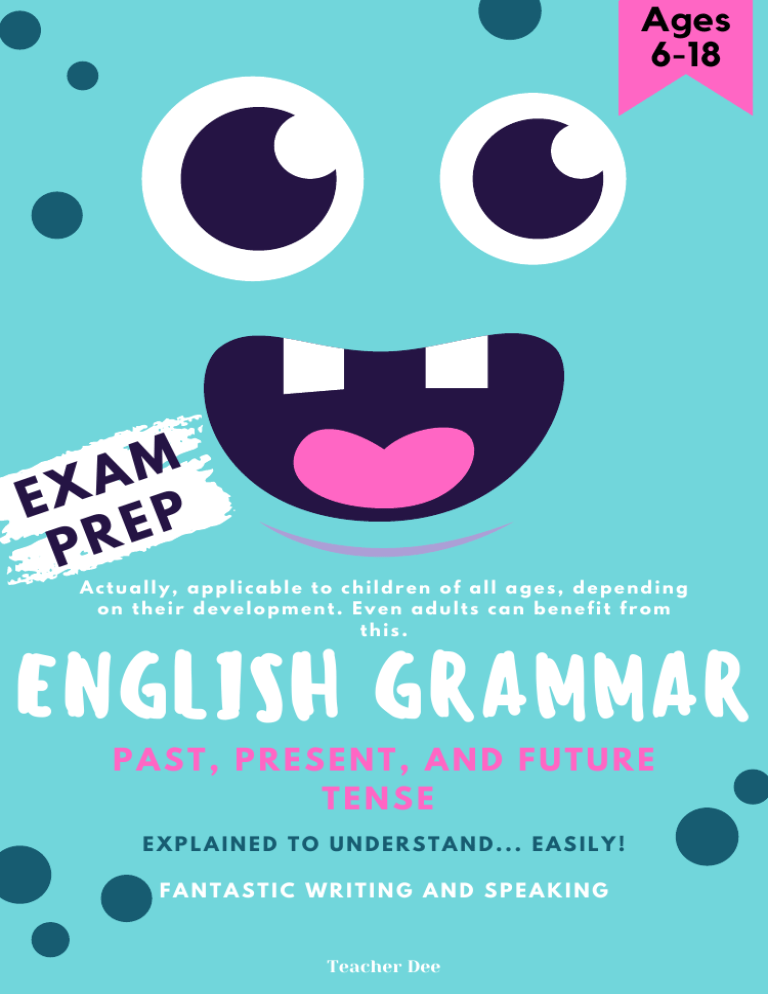
Ages
6-18
AM
X
E
EP
R
P
Actually, applicable to children of all ages, depending
on their development. Even adults can benefit from
this.
ENGLISH GRAMMAR
PAST, PRESENT, AND FUTURE
TENSE
EXPLAINED TO UNDERSTAND... EASILY!
FANTASTIC WRITING AND SPEAKING
Teacher Dee
Content
1.
2.
3.
4.
5.
6.
7.
8.
9-11.
12.
13-15.
16.
17.
18.
19.
Present Tense
Present Continuous Tense
Present Perfect Tense
Present Perfect Continuous Tense
Past Tense
Past Continuous Tense
Past Perfect Tense
Irregular Verbs - LIST
Past Participles explained
Past participles - LIST
Past Modals
Past Tense and Past Continuous Tense
Past Tense and Present Tense
Future Tense
Contraction - LIST (do not - don't)
1
1
Present
Tense
INTRODUCTION
1. It describes something that is generally true:
I live in Ireland.
She has a brother.
She is my boss.
They have supper every night at 20:00.
2. It describes a scheduled future event.
The bus leaves at 9:00 Saturday morning.
The school starts at 8:00.
3. It does not describe something that is happening right now.
Wrong: Right now, I stand in the street.
Correct: Right now, I'm standing in the street (Present Continuous Tense).
Structure of the
PRESENT TENSE is:
Structure of the
NEGATIVE is:
Structure of the
QUESTION is:
SUBJECT + VERB (+ 'S'
ENDING)
SUBJECT + DON'T/DOESN'T
+ VERB
DO/DOES + SUBJECT
+ VERB
I stand...
She stands...
You cry...
He cries...
They fly...
It flies...
I do not stand...
She does not stand...
You don't (do not) cry...
He doesn't (does not) cry...
They don't fly...
It doesn't fly...
Do I stand...?
Does she stand...?
Do you cry...?
Does he cry...?
Do they fly...?
Does it fly...?
NOTE: He/She/It takes an 's'
ending.
NOTE: He/She/It - Doesn't
NOTE: I/You/We - Don't
NOTE: He/She/It - Does
NOTE: I/You/We - Do
1
Present
Continuous
Tense
INTRODUCTION
1. It describes an action happening now.
I am driving in the car right now.
2. It describes a temporary state.
I am renting a car for the week.
Currently, we are looking for the dogs.
3. It can describe the future. ('going to' or 'planning' to')
We are moving this Friday.
I am speaking to her this afternoon.
4. Typical phrases it's used with:
-At the moment
- Currently
- Now
- Presently
- Right now
- This week
Structure of the
PRESENT
CONTINUOUS
TENSE is:
SUBJECT + AM/IS/ARE +
VERB+ING
I am climbing...
She is drinking...
You are designing...
They are flying...
He is hopping...
We are seeing...
Structure of the
NEGATIVE is:
Structure of the
QUESTION is:
SUBJECT + AM/IS/ARE +
NOT + VERB+ING
AM/IS/ARE + SUBJECT +
VERB+ING
I am not climbing...
She is not drinking...
You are not designing...
They are not flying...
He is not hopping...
We are not seeing...
Am I climbing...?
Is she drinking...?
Are you designing...?
Are they flying...?
Is he hopping...?
Are we seeing...?
2
Present
Perfect Tense
INTRODUCTION
It gives a link between the present and
the past. We focus on the result of the
action rather than the action itself.
1. Use 'HAVE' or 'HAS'.
2. It describes from the past until now.
I have been a dentist for 12 years.
We have lived in Germany since 2005.
3. Describe the current result of a previous action.
She has finally passed the exam.
I have finished my homework.
4. We do not use Present Perfect to state a specific time.
Wrong: I have been to Egypt last year.
5. 'Been' is the past participle of 'go'.
I have been to Egypt.
Structure of the
PRESENT PERFECT
TENSE is:
SUBJECT + HAVE/HAS +
PAST PARTICIPLE
I have made it...
She has kept it...
You have done it...
They have said it...
He has left it...
We have found...
Structure of the
NEGATIVE is:
Structure of the
QUESTION is:
SUBJECT + HAVE/HAS + NOT
+ PAST PARTICIPLE
HAVE/HAS + SUBJECT +
PAST PARTICIPLE
I have not made it...
She has not kept it...
You haven't (have not) done
it...
They haven't said it...
He hasn't (has not) left it...
We haven't found it...
Have I made it...?
Has she kept it...?
Have you done it...?
Have they said it...?
Has he left it...?
Have we found it...?
3
Present
Perfect
Continuous
Tense
INTRODUCTION
1. The Present Perfect Continuous Tense is also called the
Present Perfect Progressive Tense.
2. It emphasizes the action.
I am so tired because I have been working.
I have been sitting for hours.
Structure of the PRESENT
PERFECT CONTINUOUS
TENSE is:
SUBJECT + HAVE/HAS + BEEN +
VERB+ING
I have been waiting...
She has been sitting...
You have been eating...
They have been working...
He has been complaining...
We have been selling...
4
Past
Tense
INTRODUCTION
1. The 'BE' verb is formed.
We left.
2. Using 'WAS/WERE'.
They were scared.
3. Know when to use the 'BE' verb and when not to.
Wrong: I was picked up my sister.
Correct: I picked up my sister.
4. A few of the Past Tense verbs have an -ed, and a few do not.
BE CAREFUL!
Structure of the NEGATIVE is:
SUBJECT + DID NOT
+ BASE VERB
She did not win the game.
We didn't (did not) find the dog.
You didn't clean your room.
Mark didn't pass the test.
Structure of the QUESTION is:
DID + SUBJECT + BASE VERB
Did
Did
Did
Did
you introduce your friend?
she wash the dishes?
Samantha visit her friend?
the teacher teach it?
Wrong: Did she washed the dogs?
Correct: Did she wash the dogs?
Structure of the NEGATIVE with
BE VERB is:
SUBJECT + WAS/WERE NOT
She was not early.
Bella wasn't (was not) sick.
They were not playing.
The dogs weren't (were not) energetic.
I wasn't there.
Structure of the QUESTION with
BE VERB is:
WAS/WERE + SUBJECT
Was she sick?
Were they at the party?
Was Shiela naughty?
Were we too loud?
Was he in an accident?
5
Past
Continuous
Tense
INTRODUCTION
1. Past Continuous Tense is sometimes called Past Progressive
Tense.
2. WAS/WERE + VERB(ING)
They were walking.
She was swimming.
He was sleeping.
I was eating.
3. It describes a continuous or longer action in the past.
I was washing the laundry while I was cooking dinner.
'I was washing the laundry' short action
'While I was cooking dinner' longer action
4. It is used to give some background information for a story.
The sky was dark. The animals were sleeping.
Structure of the
PAST CONTINUOUS
TENSE is:
SUBJECT + WAS/WERE +
VERB(ING)
Jack was crying.
You were sleeping.
Structure of the
NEGATIVE is:
Structure of the
QUESTION is:
SUBJECT + WAS/WERE
NOT + VERB(ING)
WAS/WERE + SUBJECT +
VERB(ING)
We were not flying.
He was not playing.
They weren't (were not)
learning.
Was she focusing?
Were they studying?
Was Lucy crawling?
6
Past Perfect
Tense
INTRODUCTION
1. SUBJECT + HAD + PAST PARTICIPLE
She had forgotten.
They had left.
2. When we talk about the past, AND we want to reference a
time further in the past. You'll be talking about two different
times in the past.
When I arrived at the party, Claire had already kept a seat open
for me. (She kept the seat before I arrived)
3. Present Perfect compares a past time with the present:
I'm not running. I've already practiced.
4. Past perfect compares the past time with another time in the
past:
I was not sleeping. I had already slept.
'ALREADY' and 'NEVER' are
helping words:
When Sam left, the people had already
eaten.
Before the vacation, they had never
flown.
Peter told me that he had never been
here.
Liza said they had already felt the
earthquake.
7
Irregular
Verbs
be
become
begin
blow
break
bring
build
burst
buy
catch
choose
come
cut
deal
do
drink
was/were
became
began
blew
broke
brought
built
burst
bought
caught
chose
came
cut
dealt
did
drank
drive
eat
fall
feed
feel
fight
find
fly
forbid
forget
forgive
freeze
get
give
go
grow
drove
ate
fell
fed
felt
fought
found
flew
forbade
forgot
forgave
froze
got
gave
went
grew
8
Irregular
Verbs
have
hear
hide
hold
hurt
keep
know
lay
lead
leave
let
lie
lose
make
meet
pay
had
heard
hid
held
hurt
kept
knew
laid
led
left
let
lay
lost
made
met
paid
quit
read
ride
ring
rise
run
say
see
seek
sell
send
shake
shine
sing
sit
sleep
quit
read
rode
rang
rose
ran
said
saw
sought
sold
sent
shook
shone
sang
sat
slept
9
Irregular
Verbs
speak
spend
spring
stand
steal
swim
take
teach
tear
tell
think
throw
understand
wake
wear
win
write
spoke
spent
sprang
stood
stole
swam
took
taught
tore
told
thought
threw
understood
woke
wore
won
wrote
10
Past
Participles
INTRODUCTION
1. Every verb has three forms:
drink - drank - drunk
go - went - gone
ring - rang - rung
2. Sometimes, the Past Participle is the same as the Past Tense:
dig - dug - dug
feel - felt - felt
3. Sometimes, all three forms are the same:
cut - cut - cut
let - let - let
4. Sometimes the Past Participle ends with an 'ed' and
sometimes not.
walk - walked
steal - stole
5. List of Past Participles without -ed:
11
Past
Participle
be
become
begin
blow
break
bring
build
burst
buy
catch
choose
come
cut
deal
do
drink
been
become
begun
blown
broken
brought
built
burst
bought
caught
chosen
come
cut
dealt
done
drunk
drive
eat
fall
feed
feel
fight
find
fly
forbid
forget
forgive
freeze
get
give
go
grow
driven
eaten
fallen
fed
felt
fought
found
flown
forbidden
forgotten
forgiven
frozen
gotten
given
gone
grown
12
Past
Participle
have
hear
hide
hold
hurt
keep
know
lay
lead
leave
let
lie
lose
make
meet
pay
had
heard
hid
held
hurt
kept
knew
laid
led
left
let
lay
lost
made
met
paid
quit
read
ride
ring
rise
run
say
see
seek
sell
send
shake
shine
sing
sit
sleep
quit
read
rode
rang
rose
ran
said
saw
sought
sold
sent
shook
shone
sang
sat
slept
13
Past
Participle
speak
spend
spring
stand
steal
swim
take
teach
tear
tell
think
throw
understand
wake
wear
win
write
spoken
spent
sprung
stood
stolen
swum
taken
taught
torn
told
thought
thrown
understood
woken
worn
won
written
14
Past Modals
INTRODUCTION
1. Could, would, should, might, can, may, must, etc.
2. 'HAVE' will be used.
You must have been late.
I would have gone there.
She should have told him the story.
3. 'SHOULD' - We should have spent less money last vacation.
4. 'COULD' - I could have taken it.
5. 'MUST' - She must have been sore.
Structure of a MODEL VERB is:
SUBJECT + MODAL + HAVE + PAST PARTICIPLE
I could have been at the hospital.
You would have broken your neck.
She must have chosen the pink dress.
They should have been at the birthday.
I might have taken your schoolbag.
He must have left it at school.
Shiela might have lost it in the mall.
15
Past Tense
and Past
Continuous
Tense
INTRODUCTION
Past Tense: I walked.
Past Continuous Tense: I was walking.
1. The Past Continuous Tense is used: An action was in progress
at a particular time.
This morning, I was cleaning the kitchen.
2. The Past Simple Tense is used: An action is completed.
This morning, I cleaned the kitchen.
3. The Past Continuous Tense is used: A longer action
interrupted by a shorter action. Use 'WHILE'.
I heard the noise while I was sleeping.
She fell while she was walking to school.
4. The Past Continuous Tense is used: An action took place over
a long time.
She was sick all year around - a long time.
5. The Past Continuous Tense is used: Comparing two longer
actions.
While I was cooking, Leo was washing the dishes.
16
Past Tense
and Present
Perfect
INTRODUCTION
1. Both describe past actions.
Past Tense - He broke the vase.
Present Perfect Tense - He has broken the vase.
2. It describes from the past until now.
I have been a dentist for 12 years.
We have lived in Germany since 2005.
Only use PAST TENSE: Specific
time
YESTERDAY
LAST WEEK
LAST MONTH
IN JUNE
LAST MONDAY
ON MY BIRTHDAY
THREE DAYS AGO
Wrong: Last month, my parents have
called me.
Correct: Last month, my parents called
me.
PRESENT PERFECT TENSE:
Connection to the present
ALREADY
BEFORE
EVER
FOR
JUST
NEVER
RECENTLY
SINCE
TIMES
Wrong: She never saw her.
Correct: She has never seen her.
17
Future
Tense
INTRODUCTION
1. Things that have not happened yet.
Next year, I will compete in the competition.
2. 'GOING TO"
This expression is for more casual writing.
Structure of the
FUTURE TENSE is:
Structure of the
NEGATIVE Tense is:
Structure of the
QUESTION Tense is:
SUBJECT + WILL + VERB
SUBJECT + WILL NOT +
VERB
WILL + SUBJECT + VERB
I will go to a concert.
You will enjoy it.
They will leave tomorrow.
She will go to the
supermarket.
I will not go to a concert.
You won't (will not) enjoy
it.
They won't leave tomorrow.
She won't go to the
supermarket.
Will I go to a concert?
Will you enjoy it?
Will they leave tomorrow?
Will she go to the
supermarket?
Structure of the
FUTURE 'GOING TO'
is:
Structure of the
NEGATIVE 'GOING
TO: is:
Structure of the
QUESTION
'GOING TO" is:
AM/IS/ARE + GOING TO +
VERB
AM/IS/ARE + NOT + GOING
TO + VERB
AM/IS/ARE + GOING TO +
VERB
He is going to a concert.
You are going to enjoy it.
They are going to leave
tomorrow.
She is going to the
supermarket.
He is not going to a concert.
You are not going to enjoy it.
They aren't (are not) going to
leave tomorrow.
She isn't (is not) going to the
supermarket.
Is he going to a concert?
Are you going to enjoy it?
Are they going to leave
tomorrow?
Is she going to the
supermarket?
18
Contraction
Original two words changed to contracted words:
I am
She is
He is
It is
They are
We are
You are
Does not
Do not
Did not
Has not
Have not
Should not
Could not
Were not
Must not
Will not
Is not
Are not
Had not
I'm
She's
He's
It's
They're
We're
You're
Doesn't
Don't
Didn't
Hasn't
Haven't
Shouldn't
Couldn't
Weren't
Mustn't
Won't
Isn't
Aren't
Hadn't
19
ENGLISH GRAMMAR
PAST, PRESENT AND FUTURE
TENSE
Color can make the most significant improvement in learning. As a
teacher, it is noticeable how color can make a difference. I have
taught more than a 1000 students, and with the majority, I've seen
better improvement shifting from boring content to colorful
content. English has a lot of rules, and each one should be
remembered to the T. Therefore, we might as well just learn it in a
fun way.
The content provided is high-level educational rules, explained
easily. There is no exceptional, unique content added, as English
rules stay standard. The content is constructive, with plenty of
straightforward examples to help you grasp it quicker.
Let's get learning
Teacher D.
